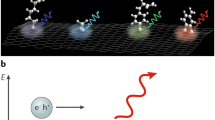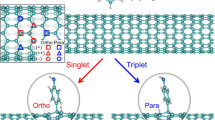Abstract
Semiconducting carbon nanotubes promise a broad range of potential applications in optoelectronics and imaging, but their photon-conversion efficiency is relatively low. Quantum theory suggests that nanotube photoluminescence is intrinsically inefficient because of low-lying ‘dark’ exciton states. Here we demonstrate the significant brightening of nanotube photoluminescence (up to 28-fold) through the creation of an optically allowed defect state that resides below the predicted energy level of the dark excitons. Emission from this new state generates a photoluminescence peak that is red-shifted by as much as 254 meV from the nanotube's original excitonic transition. We also found that the attachment of electron-withdrawing substituents to carbon nanotubes systematically drives this defect state further down the energy ladder. Our experiments show that the material's photoluminescence quantum yield increases exponentially as a function of the shifted emission energy. This work lays the foundation for chemical control of defect quantum states in low-dimensional carbon materials.
This is a preview of subscription content, access via your institution
Access options
Subscribe to this journal
Receive 12 print issues and online access
$259.00 per year
only $21.58 per issue
Buy this article
- Purchase on Springer Link
- Instant access to full article PDF
Prices may be subject to local taxes which are calculated during checkout




Similar content being viewed by others
References
Bachilo, S. M. et al. Structure-assigned optical spectra of single-walled carbon nanotubes. Science 298, 2361–2366 (2002).
Wang, F., Dukovic, G., Brus, L. E. & Heinz, T. F. The optical resonances in carbon nanotubes arise from excitons. Science 308, 838–841 (2005).
Heller, D. A., Baik, S., Eurell, T. E. & Strano, M. S. Single-walled carbon nanotube spectroscopy in live cells: towards long-term labels and optical sensors. Adv. Mater. 17, 2793–2799 (2005).
Hong, G. et al. Multifunctional in vivo vascular imaging using near-infrared II fluorescence. Nature Medicine 18, 1841–1846 (2012).
Högele, A., Galland, C., Winger, M. & Imamoğlu, A. Photon antibunching in the photoluminescence spectra of a single carbon nanotube. Phys. Rev. Lett. 100, 217401 (2008).
Chen, J. et al. Bright infrared emission from electrically induced excitons in carbon nanotubes. Science 310, 1171–1174 (2005).
Carlson, L. J., Maccagnano, S. E., Zheng, M., Silcox, J. & Krauss, T. D. Fluorescence efficiency of individual carbon nanotubes. Nano Lett. 7, 3698–3703 (2007).
Crochet, J., Clemens, M. & Hertel, T. Quantum yield heterogeneities of aqueous single-wall carbon nanotube suspensions. J. Am. Chem. Soc. 129, 8058–8059 (2007).
Nozik, A. J. Spectroscopy and hot electron relaxation dynamics in semiconductor quantum wells and quantum dots. Annu. Rev. Phys. Chem. 52, 193–231 (2001).
Lee, A. J. et al. Bright fluorescence from individual single-walled carbon nanotubes. Nano Lett. 11, 1636–1640 (2011).
Ju, S-Y., Kopcha, W. P. & Papadimitrakopoulos, F. Brightly fluorescent single-walled carbon nanotubes via an oxygen-excluding surfactant organization. Science 323, 1319–1323 (2009).
Spataru, C. D., Ismail-Beigi, S., Capaz, R. B. & Louie, S. G. Theory and ab initio calculation of radiative lifetime of excitons in semiconducting carbon nanotubes. Phys. Rev. Lett. 95, 247402 (2005).
Capaz, R. B., Spataru, C. D., Ismail-Beigi, S. & Louie, S. G. Diameter and chirality dependence of exciton properties in carbon nanotubes. Phys. Rev. B 74, 121401 (2006).
Zhao, H. & Mazumdar, S. Electron–electron interaction effects on the optical excitations of semiconducting single-walled carbon nanotubes. Phys. Rev. Lett. 93, 157402 (2004).
Ando, T. Effects of valley mixing and exchange on excitons in carbon nanotubes with Aharonov–Bohm flux. J. Phys. Soc. Jpn 75, 024707 (2006).
Scholes, G. D. et al. Low-lying exciton states determine the photophysics of semiconducting single wall carbon nanotubes. J. Phys. Chem. C 111, 11139–11149 (2007).
Peng, X. & Wong, S. S. Functional covalent chemistry of carbon nanotube surfaces. Adv. Mater. 21, 625–642 (2009).
Karousis, N., Tagmatarchis, N. & Tasis, D. Current progress on the chemical modification of carbon nanotubes. Chem. Rev. 110, 5366–5397 (2010).
Liu, H., Nishide, D., Tanaka, T. & Kataura, H. Large-scale single-chirality separation of single-wall carbon nanotubes by simple gel chromatography. Nature Commun. 2, 309 (2011).
Usrey, M. L., Lippmann, E. S. & Strano, M. S. Evidence for a two-step mechanism in electronically selective single-walled carbon nanotube reactions. J. Am. Chem. Soc. 127, 16129–16135 (2005).
Cognet, L. et al. Stepwise quenching of exciton fluorescence in carbon nanotubes by single-molecule reactions. Science 316, 1465–1468 (2007).
Harutyunyan, H. et al. Defect-induced photoluminescence from dark excitonic states in individual single-walled carbon nanotubes. Nano Lett. 9, 2010–2014 (2009).
Ghosh, S., Bachilo, S. M., Simonette, R. A., Beckingham, K. M. & Weisman, R. B. Oxygen doping modifies near-infrared band gaps in fluorescent single-walled carbon nanotubes. Science 330, 1656–1659 (2010).
Nagatsu, K., Chiashi, S., Konabe, S. & Homma, Y. Brightening of triplet dark excitons by atomic hydrogen adsorption in single-walled carbon nanotubes observed by photoluminescence spectroscopy. Phys. Rev. Lett. 105, 157403 (2010).
Kilina, S., Ramirez, J. & Tretiak, S. Brightening of the lowest exciton in carbon nanotubes via chemical functionalization. Nano Lett. 12, 2306–2312 (2012).
Zhang, Y. et al. Propagative sidewall alkylcarboxylation that induces red-shifted near-IR photoluminescence in single-walled carbon nanotubes. J. Phys. Chem. Lett. 4, 826–830 (2013).
Deng, S. et al. Confined propagation of covalent chemical reactions on single-walled carbon nanotubes. Nature Commun. 2, 382 (2011).
Dresselhaus, M. S., Dresselhaus, G. & Jorio, A. Raman spectroscopy of carbon nanotubes in 1997 and 2007. J. Phys. Chem. C 111, 17887–17893 (2007).
Torrens, O. N., Zheng, M. & Kikkawa, J. M. Energy of K-momentum dark excitons in carbon nanotubes by optical spectroscopy. Phys. Rev. Lett. 101, 157401 (2008).
Blackburn, J. L., Holt, J. M., Irurzun, V. M., Resasco, D. E. & Rumbles, G. Confirmation of K-momentum dark exciton vibronic sidebands using 13C-labeled, highly enriched (6,5) single-walled carbon nanotubes. Nano Lett. 12, 1398–1403 (2012).
Hansch, C., Leo, A. & Taft, R. W. A survey of Hammett substituent constants and resonance and field parameters. Chem. Rev. 91, 165–195 (1991).
Brédas, J. L. & Heeger, A. J. Influence of donor and acceptor substituents on the electronic characteristics of poly(paraphenylene vinylene) and poly(paraphenylene). Chem. Phys. Lett. 217, 507–512 (1994).
Ramirez, J., Mayo, M. L., Kilina, S. & Tretiak, S. Electronic structure and optical spectra of semiconducting carbon nanotubes functionalized by diazonium salts. Chem. Phys. 413, 89–101 (2013).
Acknowledgements
We thank A. Brozena and J. Fourkas for helpful discussions and K. Gaskell for assistance with XPS experiments. This work was partially supported by the University of Maryland, the Office of Naval Research (N000141110465) and the National Science Foundation (CAREER CHE-1055514). G.C.S. and N.V. acknowledge support from ARO MURI grant #W911NF-09-1-0541.
Author information
Authors and Affiliations
Contributions
Y.W. and Y.P. conceived and designed the experiments. Y.P., B.M., L.R.P. and H.K. performed experiments. N.V. and G.C.S. performed DFT calculations. Y.W., Y.P. and G.C.S. wrote the manuscript with inputs from all authors.
Corresponding author
Ethics declarations
Competing interests
The authors declare no competing financial interests.
Supplementary information
Supplementary information
Supplementary information (PDF 3654 kb)
Rights and permissions
About this article
Cite this article
Piao, Y., Meany, B., Powell, L. et al. Brightening of carbon nanotube photoluminescence through the incorporation of sp3 defects. Nature Chem 5, 840–845 (2013). https://doi.org/10.1038/nchem.1711
Received:
Accepted:
Published:
Issue Date:
DOI: https://doi.org/10.1038/nchem.1711
This article is cited by
-
Ratiometric fluorescent sensing of pyrophosphate with sp³-functionalized single-walled carbon nanotubes
Nature Communications (2024)
-
Chemiresistive sensing with functionalized carbon nanotubes
Nature Reviews Methods Primers (2023)
-
Chemomechanical modification of quantum emission in monolayer WSe2
Nature Communications (2023)
-
Long-lived electronic spin qubits in single-walled carbon nanotubes
Nature Communications (2023)
-
Selective emergence of photoluminescence at telecommunication wavelengths from cyclic perfluoroalkylated carbon nanotubes
Communications Chemistry (2023)



